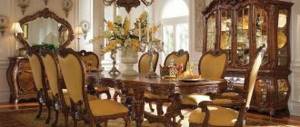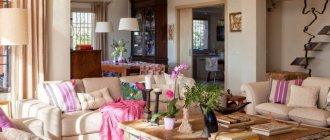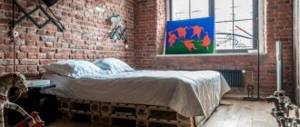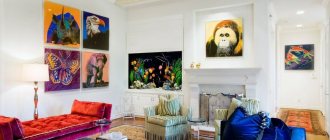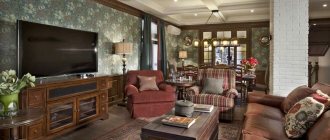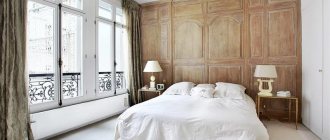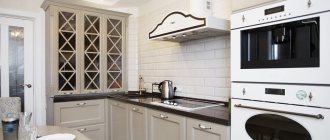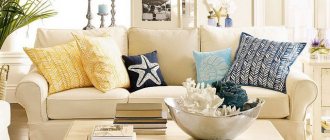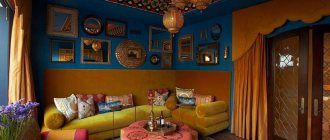More stately than classical, less pretentious than baroque, traditional and a little pompous - this is the style that became a reflection of Roman classical design with elements of ancient Egyptian culture. Moreover, it originated in France - during the reign of Napoleon Bonaparte. And the Empire style is associated with the character of this emperor, striving for the glory of the Roman rulers.
Today, rarely does anyone use such a design in its pure form, but its elements can be present in the design of noble, solemn and majestic premises. Most often it is used in official institutions - buildings belonging to government structures, in order to emphasize their importance and greatness. The office of the general director of a large corporation or the premises of a fashionable hotel can be decorated in this style.
A little history
The Empire style originated at the beginning of the 19th century, when the artist Jacques Louis David, who often depicted and praised Emperor Bonaparte, presented the ruler with furniture in his character. Napoleon and his retinue liked the products so much that the author began to regularly fulfill orders for such furniture.
But majestic design did not “rule” for very long - from about 1799 to 1814. Until this time, the priority of aristocratic interiors was French neoclassicism. Its features were antique motifs, promotion of Enlightenment ideas, rigor and restraint. It was replaced by a rather pompous, overly pompous and majestic, but not as pretentious as Baroque, Empire style. Its fragility is explained by the fact that the highest circles of society were forced to use interior elements that the emperor and his entourage liked, and after the fall of Napoleon, the popularity of the Empire style began to decline. Although similarities can be seen between classicism and empire style, which has returned to fashion.
The main idea of the style was the praise of imperial power and Napoleon himself. Much attention is paid to the military actions of the French army. Moreover, all art is strictly regulated by the authorities. By order of the monarch, the Malmaison, Versailles, Louvre and Tuileries palaces were built and rebuilt. The authors were Pierre Fontaine and Charles Percier. They made the imperial estates pompous and luxurious to express the greatness of the Holy Roman Empire, as Bonaparte demanded.
Jacques Louis David became the founder of the empire style fashion. In 1800, he painted a portrait of Madame Recamier, whom he “dressed” at his discretion in a Roman tunic. The painting showed her on a bed with a typical imperial-style curved headboard. Nearby, the artist depicted a floor lamp in the ancient Roman style. This picture can be considered the beginning of the “reign” of a new style.
In 1812, the reference book “Collection of Sketches for Interior Decoration”, created by Percier and Fontaine, was even published. The book described the use of a variety of folk motifs from all times, which proclaimed some eclecticism of the Empire style, but the basis remained the majestic Roman style.
But the desire to glorify the greatness of the Roman Empire reached the ridiculous: Napoleon obliged the courtiers to wear Roman tunics, and the elite of French society was forced to freeze in poorly heated palaces in winter.
History of style
Empire - this is how the name of the style is translated from French. Creating his empire, Bonaparte sought to unite vast territories and different peoples under his leadership. The connecting link should have been common cultural traditions. However, the severity of classicism that dominated European capitals at the end of the 18th century was not suitable for this purpose.
Therefore, in the first decades of the 19th century, a new style emerged in architecture, painting, literature and, of course, interior design. The French painter who glorified the emperor and his retinue in his canvases, Jacques Louis David, worked on the creation of the Empire style. It praises the ruler's military exploits, depicting him riding a hot horse. In addition, he makes beautiful lacquered furniture, decorated with expensive mosaics and ornaments, and presents it to Josephine. This approach was very generously appreciated by the authorities. Large orders begin to be placed on David, and he becomes famous.
Architecture also developed under the influence of the monumental paintings of Jacques Louis. Grandiose palaces are rebuilt for the ruler, delighting with their beauty and pomp. The names of the architects Pierre Fontaine and Charles Percier, who renovated the Tuileries and Louvre, are becoming famous. Based on their sketches, famous furniture sets in the Empire style were made.
Interior of the Louvre.
Interior design in the Empire style has penetrated into Russia. The influence of French culture was great at the beginning of the 19th century. Famous people invited French tutors, painters, and architects. It was fashionable not only to dress in the French manner, but also to express one’s thoughts using a foreign language. Henri de Montferrand and Karl Rossi were invited to Russia to build palace complexes and cathedrals. In their performance, the Empire style sounded softer and more flexible.
Interior of the Pavlovsk Palace.
Features of the French Empire style
The French Empire style in the interior extols Napoleon, so it is characterized by ostentatious pomp and grandeur. The origins of the style go back to Ancient Rome with its attraction to grandeur and symmetry. Many interiors are decorated with columns, antique sculptures, and voluminous stucco moldings. For surface finishing, natural wood, mirrors, and bronze are used. The walls are decorated with paintings and portraits in massive frames. The ceilings look like works of art. They are complemented by carvings, stucco moldings, and gilding.
Their main decoration is the magnificent chandeliers with crystal pendants. Empire style furniture looks solid and impressive. Her appearance is influenced by the events of the military campaign in Egypt and her passion for Roman traditions. Chairs with straight backs are decorated with overlays with lion heads, their legs are shaped like lion paws or Roman columns. For the manufacture of furniture, valuable types of wood, natural marble or porphyry are used.
French Empire is the style of halls for official receptions and special events. It is designed to delight and enchant, to conquer at first sight. Empire style is more suitable for decorating offices, state rooms, large dining rooms and living rooms. Less often, bedrooms are decorated with it.
Features of the Russian Empire style
The fashion for everything French appeared under Emperor Paul. However, importing furniture purchased in France into Russia was strictly prohibited. This ban continued under Alexander I. However, during his reign, furniture in the Empire style began to be made in Russia. Albums with sketches of the best architectural buildings, interiors, and furniture are sent from France to Alexander I. Furniture is ordered from the best craftsmen, who make it from mahogany and Karelian birch, and decorate it with mosaics and carvings. However, it turns out not so heavy and straightforward.
The furniture made for the capital is most similar to the French original. Orders for the provinces (Moscow landowners) have soft forms, they are not so elegant and official, and have a more homely appearance. So the “Russian Empire” is divided into two types - metropolitan and provincial. For palace interiors in St. Petersburg, they ordered furniture made of mahogany or rosewood with gilded overlays and magnificent mosaics. Silk or velvet was used for upholstery. For Moscow interiors, furniture was made from simpler wood species - ash, walnut, linden. Chintz was chosen as upholstery.
Varieties of Empire style in the world
Moving in his conquests across the continent, Napoleon imposed his invented style everywhere. Of course, it did not fit in well, because it had no cultural justification other than the greatness of the emperor. But, interestingly, the Empire style took root and even became popular in Russia: here - in a country that was also spreading its wings as a powerful state - the glorification of imperial power also became relevant, only, of course, it was not Bonaparte who was exalted to the top, although some During this time, the empires coexisted peacefully, and the French monarch even sent Alexander I an image of the “new buildings” of Paris. This style also became fashionable in the highest circles of Russian aristocratic society. As a result, the directions split.
The “Russian Empire” proved to be a little softer than the French one. It was more classical than it owed to the famous architect C. Rossi. In addition, the Russian interpretation of the imperial style was divided into metropolitan and provincial directions, which was not the case anywhere else, even in France itself. However, the provincial design direction was still more reminiscent of classicism because of its restraint and plasticity.
Characteristic features of the style
With the advent of the Empire style, interiors and furniture become heavy. At the same time, the solemnity of the design is preserved and even exaggerated to some extent. Order systems are widely used here, which manifest themselves not only in the abundance of regularly installed columns, but also in parallel, symmetrical, opposing elements and planes.
The outlines are predominantly rectilinear and massive. There is a clear and understandable geometry. A prerequisite is the features of ancient architecture. But if classicism used ancient Greek motifs, now ancient Roman details are becoming more relevant. The triumphal arch is increasingly used as an element of structures and decor.
There are other differences that made it possible to separate the Empire style from classicism:
- A muted and restrained palette is losing its relevance. It is being replaced by rich, but, of course, not colorful solutions.
- Empire style is a colder and rather rigid style. This is explained by the dictatorship of Napoleon and his admiration for the military victories of the ancient Romans.
- The imperial direction in interior design does not seek to displace classical traditions, but largely uses them. But at the same time, the new design demonstrates the degeneration of the values of the previous era.
- Empire style became a decoration for developments on the political front, losing its real artistic value and relegating all the values of classicism to the background.
An example of a typical wall decoration is wallpaper with imitation wood paneling, invented by the decorator J. Zubert. Another designer of that time, J. Dufour, proposed different wallpapers - with paintings on themes of Roman myths. In general, the Empire style was not devoid of romance and admiration for the ancient epic. But the basis of all the decor is the motifs of the Roman campaigns.
For all its eclecticism, the Empire style never used an excessive mixture of styles and motifs, so you should always choose a strict composition.
Main features of the Empire style
1. Large area and grandeur are the main features of the style. Empire is a historical style designating the interiors of palaces and residences of emperors. It gives the premises a majestic and solemn look. Today it is chosen for decorating high-status rooms in high-class hotels, interiors of country houses and villas, and banquet halls in restaurants.
2. Use of centric composition. The principles of surface finishing and furniture arrangement in a large room are most often based on a radial or centric composition. As a rule, the center of the floor and ceiling is emphasized by a pattern.
3. Items of antiquity and military glory for interior decoration. Sculptural groups, porcelain vases, and bronze candlesticks are placed along the perimeter of the hall for formal receptions or the front living room.
4. Large mirrors. I use them to highlight the shine of golden surfaces and reflect the splendor of the setting. The mirror must be large, framed in a massive frame.
Empire style color palette
The basis of the composition is mahogany - a luxurious and truly rich solution. The interior uses a lot of bronze, matte black and patinated metals. Lamps, vases, clocks, and furniture decor are made from bronze.
Companions in the palette of the room are most often the colors of the imperial flag - red, blue and white. These shades are used in a rich, bright form. Often they cover walls and are used in furniture upholstery. Soft velvet surfaces are often made in a dark and rich crimson color.
Choosing furniture
Furniture in delicate cream shades in the kitchen interior
Today, the most popular material used to create furniture in the Empire style is light wood. It is from this that doors and window frames are made when renovating a kitchen, living room or other room in this style.
Like other classical styles, the Empire style loves everything antique. That is why white wood structures can be decorated with various forged figures, candlesticks or other accessories. The most important thing is to know when to stop, since failure to maintain balance will turn the Empire style kitchen into a laughing stock. The fact is that this is one of the few classic styles in which the interior should not look overly pretentious. This leads to another distinctive feature of this style - moderation in everything.
Stylized kitchen cabinets are usually made with glazed doors, so that through them you can admire the magnificent dishes with exquisite patterns.
Kitchen tables in this interior have elegant carved legs, as well as a massive and heavy tabletop. The chairs placed next to them are covered with genuine leather and complemented by elegant armrests.
Dining room furniture with gold accents in an empire style kitchen
If upholstered furniture is used, it must also be massive, voluminous and squat. In addition, there is a certain symmetry in furniture for the Empire style, and most of the legs are made in the shape of animal paws. Quite an interesting and unusual idea. The upholstery is made of luxurious soft fabrics or genuine leather. It is possible to use leatherette, but it must be of excellent quality.
Advice! As mentioned earlier, the Empire style welcomes symmetry, which can be seen in the number of chairs, armchairs and poufs - it must be even.
Shapes and lines
The bombast of the geometric and fairly symmetrical style is expressed in many details:
- The contrast of a clean wall without patterns is combined with narrow belts of ornaments present in the details of furniture, decorative vases and other elements that are necessary to outline structural units.
- The ornament is based on geometric shapes - rhombuses, ovals, circles. But it can also be plot-based - a whole string of Roman military processions. Although bees and stars are more often used - a typical Napoleonic pattern. As a rule, such elements are present in the form of gold or silver embroidery on a velvet green, silk crimson or satin blue background.
- The decoration often uses Roman military motifs - shields, crossed swords. The family coat of arms can be used in a similar way. It will be a wonderful decoration for a real family nest.
- Rich volumetric relief is used in the decoration of both surfaces and structures, as well as furniture. These include pilasters, stucco molding, figurines, frescoes, and imitation columns.
- The shapes of furniture and details are monumental and solemn, therefore they are completely inapplicable in cramped spaces.
Style Features
To create furniture in the Empire style, some of the most valuable solids are used, such as mahogany, walnut and others. Such furniture, as a rule, has impressive dimensions and rectilinear shapes, so the rooms are selected accordingly; for example, a dining table could occupy almost the entire dining room.
There are many important elements for creating an interior to suit the style, for example, it is accepted that an empire sofa should have pillows, a lot of mirrors should be used and they can be placed in the most unusual places: above the bed, between windows, above tables. By the way, mirrors above dressing tables appeared thanks to this style.
Despite the craving for luxury, the Empire style can also be quite cozy. Soft, stylish furniture creates a warm, relaxing atmosphere in the room.
The Empire style living room is furnished with appropriate furniture. Correctly selected decorative elements make the overall picture complete and whole.
Cabinet furniture is usually decorated with decorative columns and pilasters. Expensive, natural fabrics such as silk and linen are used for windows and walls.
Elegant stucco is used on the ceilings or they are left in ordinary, classic white; in the simplest version, parquet is laid on the floor, but it is customary to “dress” the floor in marble or other natural stone. Carpets are matched to the color of the furniture. An indispensable detail in the Empire style are sculptural high reliefs depicting a lion, sphinx, swan, and griffin. There should be lamps in every room.
The Empire style dining room set is made of natural wood. The upholstery on the chairs is made of checkered fabric and harmonizes with the overall color scheme of the interior.
The elegant bedroom is decorated in Empire style. A bed with a high headboard upholstered in natural silk stands in the center of the design composition.
Materials
As in classicism, the interior in the Empire style uses expensive, luxurious, outwardly very rich materials. But if in a classic design these are nobly restrained solutions, here in bright blue or crimson colors they look expensive to the point of vulgarity. Especially in combination with gold, bronze, silver trim against a background of contrast, such shades emphasize the richness of the decor.
Thus, natural stones, solid wood, crystal, real bronze and silver are used in decoration and interior details. Textiles also need to be expensive - velvet, silk, cotton velor, brocade, etc.
Floor coverings
Floors are usually covered with wood or stone. Of course, ceramic tiles are also applicable, but with stone imitation, since in itself they do not belong to such luxurious materials as marble or granite. Parquet is made from wood, which will be most appropriate in this style. It is only important to choose an expensive type of wood - with a rich and varied texture.
Walls
The walls are traditionally covered with textiles - brocade or silk. Of course, in a modern interior it will most likely be wallpaper with imitation fabric drapery. If you choose simply textured coatings, they may contain a voluminous gilded pattern - just as ornate, but more elaborate than in the classic style.
Ceilings
The ceilings are painted in a traditional white or milky color. Among modern solutions, only matte stretch ceilings or painted plasterboard are appropriate. But without fail this surface is decorated with stucco and bas-reliefs. In particularly spacious halls, statues of Atlanteans supporting the ceiling would also be appropriate.
Furniture
As already mentioned, furniture is usually represented by mahogany products. Applicable species are Karelian birch and walnut. The models are equipped with carvings and three-dimensional details - figures of animals, mythical creatures, Roman gods.
It's all about the color
Empire style is, first of all, luxury. Therefore, colors in this style need rich, bright, but at the same time calm and proud. Classic of the genre - gold. This is a symbol of power and wealth, so you can feel free to use gold trim as decoration.
As base colors in the Empire style, it is best to choose noble, rich colors: blood red, deep blue, sky blue or white. However, you should use color combinations carefully. To avoid getting avant-garde instead of the Empire style, you need to keep the premises in a certain color scheme, avoiding tricolors. The walls, floor and ceiling should be in harmony with each other.
Features of the Empire style in the interior
In the Empire style, walls play an important role. They occupy the lion's share of the room's space and attract attention even at the entrance. Therefore, silk or brocade fabrics are most often used as wall decoration.
Empire style in the interior
Empire style design idea
Walls
Considering the progress achieved in modern interiors, expensive fabrics can be replaced with textured coatings that imitate woven materials. Wallpaper decorated with African motifs or military-themed symbols will look best. If you need to create a more formal atmosphere, you can use textured wall coverings with a simple, monosyllabic pattern.
Also, the walls, when decorating rooms in the Empire style, are usually decorated with blind arcades, Roman columns, medallions, frescoes and bas-reliefs. Artistic decorative elements decorating the walls must certainly intersect with military themes. Large mirrors are a must.
Empire style in the interior of the room
Empire style room design
Modern apartment design in Empire style
Ceiling
The ceiling is no less important. To design it, you also need to use only natural and expensive elements. A large crystal chandelier should be placed strictly in the center. Around the main part, the ceiling is decorated with gilded stucco. The color is most often white, but you can take liberties and use milky or light beige materials for painting.
Floor
If we are talking about the Empire style, then the choice of floor coverings is not very large. You can use either mahogany parquet or marble mosaics, with motifs from Greek or Roman artwork.
Window
Windows, depending on the purpose of the room, can be decorated with silk curtains or multi-layered heavy fabrics with fringes. The color palette of the curtains should be in the style of imperial palaces - purple, red base with gold embossing and edging.
Empire style in the interior
Empire style design idea
Furniture
Empire style furniture is heavy objects made of mahogany, decorated with carvings and gilding. The surface of furniture in an Empire style interior is always smoothly polished, the legs are most often made like lion paws, Egyptian sphinxes or Roman columns. When choosing furniture for a modern living room, it is best to give preference to antique samples.
Rooms decorated in an imperial style will be perfectly complemented by antique chests of drawers, sideboards, round tables, and elegant couches with soft shapes. By the way, the Empire style acquired smooth features after adaptation to the Russian public. The French, called upon by the nobility, decorated the estates of the nobles, softening the military-triumphal forms of the French style.
Empire style in the interior of the room
Empire style room design
Modern apartment design in Empire style
Interior decoration
The decor can safely be called the most important detail in the composition in the Empire style. It is he who is intended to express all the greatness that is invested in such a design. Despite the pompous design, the decoration of the premises should be thought through carefully. The compositional possibilities for using ornament described above can be combined, but it is important to place them so that there is no feeling of an intrusive planting of patterns and details. Grandeur and real rich luxury cannot be tasteless. Of course, in an Empire style interior, aristocracy manifests itself in the demonstration of wealth, but you still need to always remember about a sense of proportion.
Among the decorative details are not only stucco moldings and bas-reliefs, but also:
- marble vases;
- boxes inlaid with precious metals;
- mirrors in formal and openwork frames;
- china;
- massive watches - both made of expensive wood, bronze and stone;
- paintings depicting battles and historical events;
- antique statues;
- pompous lamps - made of crystal, bronze, and other metals.
Heavy curtains are also a decorative element. As a rule, they are combined with forged cornices and light curtains, varying the decor and mood. Curtains are decorated with draperies, fringes, lambrequins, and gold embroidery.
The role of color in creating an interior
For interior design in the Empire style, the main color is gold. It is he who is intended to emphasize the power and status of the palace environment.
The shine of gold is perfectly emphasized by:
1. White color, creating the impression of sophistication and elegance. This combination is typical for decorating ceilings and walls.
2. Red, wine red, emphasizing strength and eminence. It is most often used for textile decoration (red carpets, upholstery of sofas and chairs, curtains).
3. Noble blue, emitting cold energy, was used to decorate living rooms or boudoirs. In the Empire style it is less significant in status than the color red. Accordingly, it was used for decorating less important rooms.
